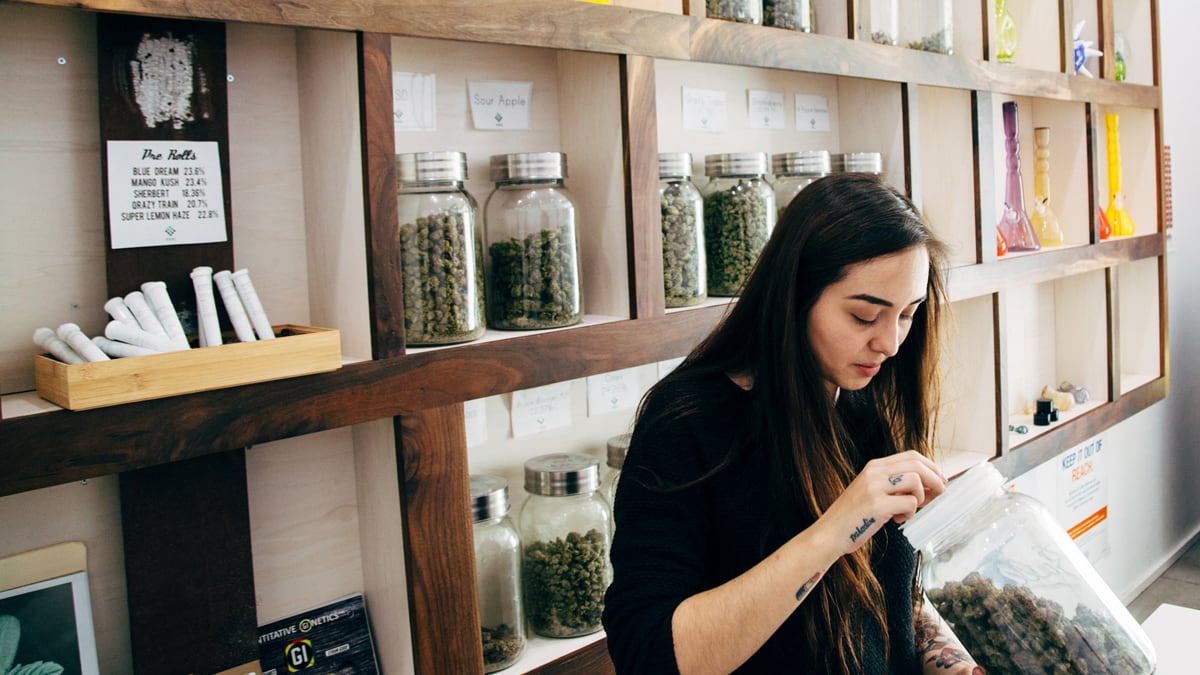At least one Oregon product has proved immune to inflation: weed.
In fact, the price of cannabis flower is as low as it’s been since April 2019. It’s retailing at $4.29 a gram, according to an Oregon Liquor and Cannabis Commission database.
The reason for the bargain shopping might give you déjà vu: Oregon has an oversupply of weed and too little demand. That’s a phenomenon that has occurred here before—most dramatically in 2018, when growers oversaturated the market and found themselves sitting on worthless cannabis harvests (“Too Much Weed,” WW, April 18, 2018).
But even then, sales were brisk. What’s driving the low prices this time is a different phenomenon: Portlanders’ appetite for cannabis has plummeted.
In July 2020, Portland residents bought $21 million worth of flower, the most weed ever purchased in a single month. This June, sales fell to $11.5 million—the lowest since June 2019.
“No one’s selling anything, which means no one’s buying anything,” says Bret Born, owner of Northeast Portland cannabis shop Ascend. “Vendors and shops are saying that this isn’t a gangbuster summer. Leading into the fall and winter, we could really be looking at tough times.”
Since the launch of Oregon’s legal recreational cannabis market in 2016, sales have increased steadily. But they skyrocketed in 2020, when many Oregonians found themselves working from home and receiving a couple of healthy stimulus checks.
In five months, sales increased by 79%. On average, weed shops were making $48,000 a month in Multnomah County in July 2020, the OLCC says.
Onlookers dubbed it “the pandemic bump,” and state economists warned it was unlikely to last. It didn’t.
Last month, retail cannabis shops across Multnomah County made the lowest monthly profit they have since early 2019, averaging just $27,000.
So why are Portlanders smoking less weed?
Anecdotally, those in and around the industry think a big part of it has to do with Portlanders returning to office cubicles or jobs they lost during the pandemic. Beau Whitney, who runs the research firm Whitney Economics and publishes reports on the hemp and cannabis industries, says many Oregonians are finding they can no longer “work from stoned.”
And as inflation soars for everything else, consumers get more cautious about their extracurricular spending.
“We’re pretty far away from stimulus payments with COVID-19, and inflation has crept up. I feel like, for a lot of people, cannabis dollars are discretionary dollars,” says Mason Walker, co-owner and CEO of East Fork Cultivars in Takilma, Ore. “People are tightening their belts a little bit.”
He says his farm projected it would sell 50 to 60 pounds of cannabis to retailers in June. Instead, it sold only 30 pounds.
“I think everyone in the industry is feeling the slump right now and trying to figure out if it’s a temporary or permanent thing,” Walker says.
Cannabis entrepreneurs have proven nimble in the face of previous obstacles. When farmers grew a huge overabundance of weed in 2018, they sent it to processors to make oils and extracts. When a spate of armed robberies at weed retailers in the Portland area in 2020 and 2021 left one budtender dead and hundreds of others traumatized, retailers boarded up their windows, installed security cameras, and hired security guards.
But there’s one challenge that’s hard to overcome just by sheer force of will: consumer unenthusiasm.
For one, weed can’t be sold out of state. That means retailers, producers and growers are confined to customers within Oregon. And if those customers are no longer the stoners they were two years ago, shops have little recourse.
The Oregon Liquor and Cannabis Commission, which oversees weed production and sales in the state, takes a slightly less dismal view.
TJ Sheehy, director of analytics and research for the OLCC, says that if you take out the anomaly years of 2020 and 2021, 2022 is actually in line with the consumption trends we were seeing in 2019. (Similarly, retail alcohol sales are down in Oregon, but bars and restaurants are buying more.)
“We had a big pandemic bump, but that has proved ephemeral. Now we’re back to normal,” Sheehy says. “But because we had that COVID-19 bump, businesses were responding to that when making their planting decisions, so that exacerbated the higher-supply issue.”
In short: Farmers didn’t learn their lesson in 2018 and once again overplanted.
The customer shortage hasn’t yet caused cannabis retailers to shutter, according to OLCC officials who track licenses. But Whitney expects that to happen soon: He estimates the annual revenue a weed shop needs to turn a profit is $2 million, and few are doing such brisk sales.
A recent move by the Oregon Legislature directed the OLCC to pause processing all new cannabis license applications in hopes the market would even out. The moratorium, retroactive to all applications filed as of Jan. 1 of this year, is set to expire in March 2024.
“It gave the OLCC the discretion to enact a moratorium on all action types based on market demand,” says cannabis lawyer Kevin Jacoby, “in the hopes it would put some upward pressure on wholesale prices. It didn’t at all.”
In June 2020, Oregon had 671 cannabis retailers statewide. In 2021, that number jumped to 756. In 2022: 794. That number will jump one more time—likely by around 100, according to Sheehy, before the number stagnates.
More retailers entering the market might make for an even thinner demand at each shop. “Right now, it’s kind of a somber outlook for weed,” Whitney says.
If there’s a silver lining for cannabis farmers: At least they’re not in the hemp-growing business.
That industry has cratered to a remarkable degree, Whitney notes. In 2019, a pound of hemp biomass sold for $43. In late 2021, it cost $1.50. And licensed acreage in Oregon dropped from 64,000 acres to 7,000.

